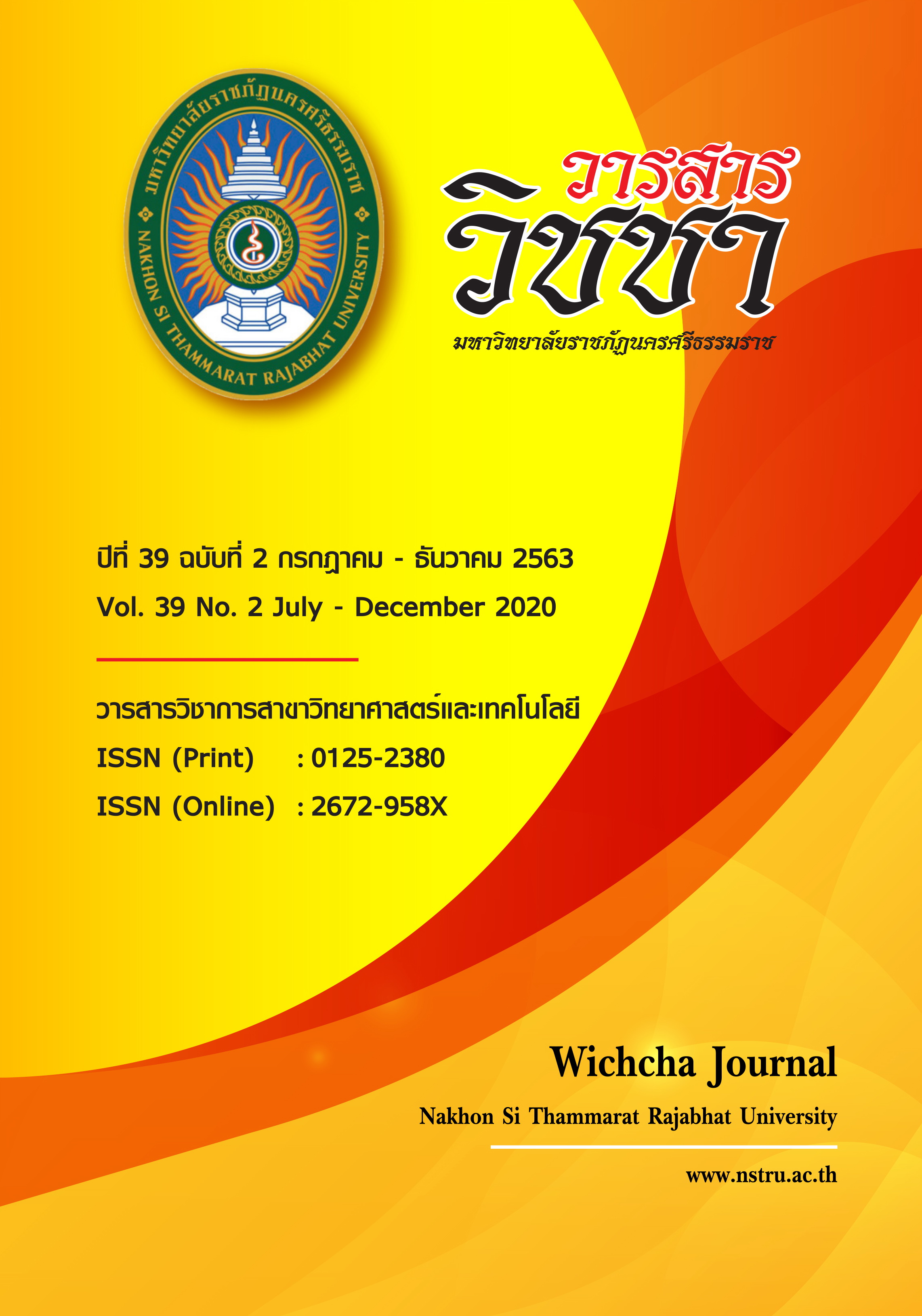Antimicrobial Activity of Copper Complexes and Carboxylic Acid Derivatives ฤทธิ์ยับยั้งเชื้อจุลินทรีย์ของสารประกอบเชิงซ้อนทองแดงและอนุพันธ์ของกรดคาร์บอกซิลิก
Main Article Content
Abstract
The research studied the synthesis of two copper complexes; namely, (1) [Cu(H2O)(PABA)2] and (2) [Cu2(tartaric)2(H2O)2]•4H2O. The substance structure were analyzed by X-ray diffraction technique on a single crystal. Basic functional groups were analyzed using infrared spectroscopy and the light absorption bands were studied by UV-Visible Spectroscopy. It was found that the complexes (1) had an orthorhombic crystal system. There were Pmc2 intersection groups and complexes (2) were monoclinic. There were P21 intersection groups. For basic function group analysis, it was found that the complexes (1) had functional groups O-H, N-H primary, C=O, C=C, C-N and C-H bending, and complexes (2) had functional groups O-H stretching, C-H stretching, carboxylic group stretching, C-O-C and Cu-O. The research studied the absorption bands of a substance at a wavelength of 200-800 nm. The absorbance bands of the substance were found at the maximum wavelengths of 231 and 740 nm. in the complexes (1). Besides, at maximum wavelengths equaled to 280 and 603 nm. in complex compounds (2). This was corresponded to electron transitions within ligand orbitals and electron transitions inside metal orbitals. Results from the study of the inhibitory efficacy and the lowest concentrations of the two complex compounds at the concentration of 80 mg/ml. With six microorganisms (Staphylococcus aureus, Bacillus subtilis, Escherichia coli, Pseudomonas aeruginosa, Klebsiella pneumonia and Acinetobacter baumannii), it was found that both complexes had antimicrobial activity at a concentration equaled to 80 mg/ml.
Article Details
เนื้อหาและข้อมูลในบทความที่ลงตีพิมพ์ในวารสารวิชชา มหาวิทยาลัยราชภัฏนครศรีธรรมราช ถือเป็นข้อคิดเห็นและความรับผิดชอบของผู้เขียนบทความโดยตรง ซึ่งกองบรรณาธิการวารสารไม่จำเป็นต้องเห็นด้วยหรือร่วมรับผิดชอบใด ๆ
บทความ ข้อมูล เนื้อหา รูปภาพ ฯลฯ ที่ได้รับการตีพิมพ์ในวารสารวิชชา มหาวิทยาลัยราชภัฏนครศรีธรรมราช ถือเป็นลิขสิทธ์ของวารสารวิชชา มหาวิทยาลัยราชภัฏนครศรีธรรมราช หากบุคคลหรือหน่วยงานใดต้องการนำข้อมูลทั้งหมดหรือส่วนหนึ่งส่วนใดไปเผยแพร่ต่อหรือเพื่อการกระทำการใด ๆ จะต้องได้รับอนุญาตเป็นลายลักษณ์อักษรจากวารสารวิชชา มหาวิทยาลัยราชภัฏนครศรีธรรมราชก่อนเท่านั้น
The content and information in the article published in Wichcha journal Nakhon Si Thammarat Rajabhat University, It is the opinion and responsibility of the author of the article. The editorial journals do not need to agree. Or share any responsibility.
References
กอรีอะ บิลหลี มณฑล เลิศวรปรีชา กุสุมาล น้อยผา และหิริหัทยา เพชรมั่ง. (2558). สเปกโทรสโกปี โครงสร้างและฤทธิ์ต้านจุลชีพของสารเชิงซ้อนทองแดงกับลิแกนด์อนุพันธ์กรดเบนโซอิก.วารสารมหาวิทยาลัยทักษิณ, 18(2), 60-69.
นินูรอัสมีน นิสมิ หิริหัทยา เพชรมั่ง และมณฑล เลิศวรปรีชา. (2559). ฤทธิ์ต้านจุลชีพของสารประกอบเชิงซ้อนทองแดงกับลิแกนด์ของอนุพันธ์กรดเบนโซอิก. การประชุมวิชาการระดับชาติเครือข่ายวิจัยสถาบันอุดมศึกษาทั่วประเทศ. นครราชสีมา.
เย็นหทัย แน่นหนา. (2549). สเปกโทรสโกปีสำหรับเคมีอินทรีย์. กรุงเทพฯ: จุฬาลงกรณ์มหาวิทยาลัย.
หิริหัทยา เพชรมั่ง. (2549). เคมีอนินทรีย์ 2. สงขลา: มหาวิทยาลัยทักษิณ.
Ashu, C., Ratan, S. and Singh, R. (2002). Tetraazamacrocyclic complexes of tin (ii) synthesis spectroscopy and biological screening. Boletin de la Sociedad chilena de Quimica, 47(3), 203-211.
Ian, S.B. and John, F.H. (1989). Inorganic chemistry principles and applications. California: Benjamin-Cummings Pub Co.
Lim, E.K, Teoh, S.G., Goh, S.M., Chng, C.D., Ng, C.H., fun, H.K., Rosli, M.M., Najimudin, N., Beh, H.H., Seow, L.J., Ismail, N., Lsmail, Z., Asmawi, Z. and Chea, Y.H. (2009). Characterization, nucleolytic, cytoxic and antibacterial property of tetrakis (µ-4-chloro-2-nitrobenzoalo-k2O, O1) bis [aquacopper (II)], tetrakis (µ-2-chloro-6-fluorobenzoalo-k2O, O1) bis [aquacopper (II)] and tetrakis (µ-2-chlorobenzoalo-k2O, O1) bis [aquacopper (II)]. Polyhedron, 28, 1320-1330.
Manihshet, A.H., Sarsamkar, S.K., Deodware, S.A., Kamble, V.N. and Asabe, M.R. (2011). Synthesis, characterization and antimicrobial activity of new cobalt (II), nickel (II), and copper (II) complexes with 2-(2-hydroxy-1, 2-diphenylehylidene amino) benzoic acid. Inoranic Chemistry Communications, 14, 618-621.
Araban, M., Tavafian, S.S., Zarandi, M.S., Hidarnia, R.A., Burri, A. and Montazer, A. (2017). A behavioral strategy to minimize air pollution exposure in pregnant women: a randomized controlled trial. Environmental Health and Preventive Medicine, 22, doi: https://doi.org/10.1186/s12199-017-0633-8.
Nair, M.S., Arih, D. and Joseyphus, R.S. (2010). Synthesis characterization antifungal antibacterial and DNA cleavage studies of some heterocyclic Schiff base metal complexes. Journal of Saudi Chemical Society, 16(1), 83-88.
Rissanen, K., Valkonen, J., Kokonen, P. and Leskela, M. (1987). Structural and thermal Studies on Salicylato Complexes of Divalent Manganese Nickel Copper and Zinc. Acta chemica Scandinavica, 41(6), 299-309.
Saif, M., Mahmoud, M., Mohamed, F. and Fouad, R. (2011). Synthesis and thermal studies of tetraaza Macrocyclic ligand and is transition metal complexes DNA binding affinity of copper complex. Spectrochimica Acta Part A: Molecular and Biomolecular Spectroscopy, 79(5), 1849-1855.
Sharma, A.K. (2006). Vishal’s Kit Objective Chemistry. (17nded). Arihant: Vishal Prakashan Mandir.
Sushil, K.G. and Daisy, R. (1997) Template synthesis characterization and electrochemical studies of copper (II) macrocyclic complexes derived from 4-methyl-2, 6-di (formyl/benzoyl) phenol and diamines. Transition metal chemistry, 22(3), 225-228.


